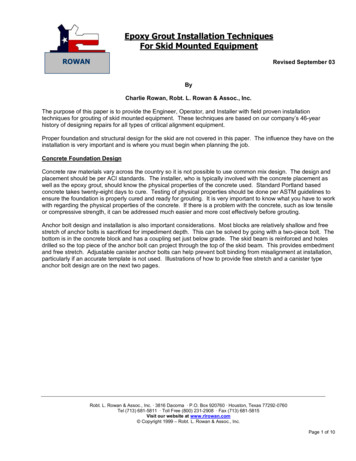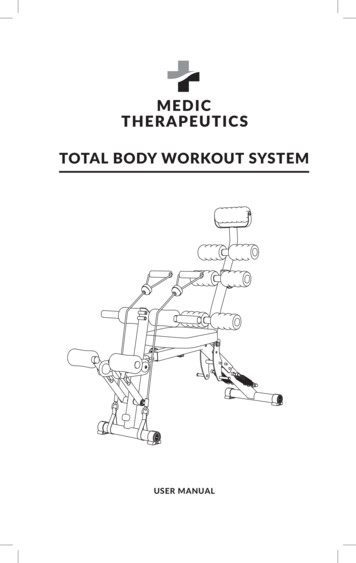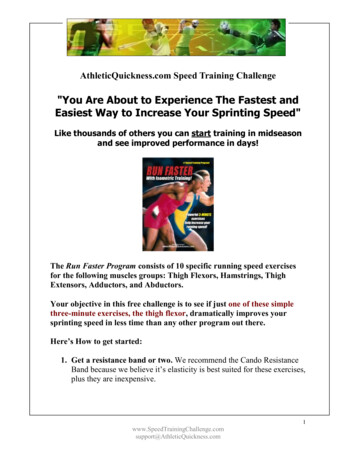
Transcription
Datasheet july2002Skid Resistance of ResidentialConcrete Paving Surfacesmicrotexture λ 0.5 mm0–0.2 mm (amplitude)macrotexture0.5 mm λ 50 mmλ IntroductionA study has been undertaken by the Cement andConcrete Association of Australia to assess theskid resistance qualities of decorative concretefinishes used in residential streets, footpaths,cycleways and pedestrian areas. The studycomprised a literature review of skid resistanceand experimental work, both in the laboratory andin the field.The literature review considered the followingaspects:nwhat statutory requirements exist at present forskid resistance;nthe major factors affecting skid resistance ofvarious surfacing types; andntypical skid resistance ranges for surfacingcurrently in use.Figure 1 Comparison between microtexture andmacrotexture (after Rogers & Gargett)1SKID RESISTANCE OF CONCRETE SURFACESSkid resistance is described as the ability of asurface to provide friction to a reference tyre orslider usually measured wet. Skid resistance isprimarily dependent upon the surface macro andmicrostructure, see Figure 1.Other parameters affecting skid resistance are:nenvironmental conditions including surfacecontaminants and temperature;nphysical properties of the paving materials;nage of pavement and traffic volumesnpavement geometry; andnseasonal conditions, ie amount of rain. The experimental work was conducted in order to:nDetermine and compare the skid resistancequalities of various concrete paving types thatare used for residential streets and pavements.nCompare these results with any establishedskid resistance criteria.nDetermine whether particular surface finishesor concrete paving types are more appropriatefor different applications.0.2–3.0 mm(amplitude)Skid resistance is describedas the ability of a surface to providefriction to a reference tyre or sliderusually measured wet
Devices for Measuring Skid ResistanceHigh speed devices – SCRIM (Sideways forceCoefficient Routine Investigation Machine) is avehicle-mounted device comprising one or twospecially manufactured testing wheels and awater tank which continually tests the pavementsurface for skid resistance. The measure of skidresistance from SCRIM is termed the SidewaysForce Coefficient (SFC) and is expressed as aratio of the sideways force upon a free-to-rotatetest wheel which is angled to the direction of travel,and the vertical force exerted by the mass of theequipment.ROAR is a trailer-mounted device towed by avehicle which can operate in either a fixed degreeof slip or in a variable slip mode. The basic unitcomprises a precision hydraulic brake machinewith a standard ASTM 1551 test tyre. ROAR isable to measure surface friction over a range ofslip speeds.Low(er) speed devices – British Pendulum,also known as the Portable Skid ResistanceTester, is a device primarily used in a laboratory todetermine the frictional qualities of small areas ofsurfaces, typically sealing aggregates. The unitof measure is the Skid Resistance Value or theSkid Resistance Number and is approximately100 times the value of the coefficient of friction(Kennedy et al)2. Details of the test are in BS 812:Part 114 and in AS 1141.42 with preparation ofsamples as given in AS 1141.40 and AS 1141.413.The Grip Tester is a device that can be towedby a vehicle or pushed by hand and can thustest confined areas such as intersections andpedestrian walkways where devices like SCRIMand ROAR can not easily access. This devicemeasures a wet coefficient of friction using abraked wheel aligned in the direction of travel.Drag and load are continuously measured andthe quotient is displayed on a laptop computer.The force on the axle due to the surface frictionis divided by the mass of the assembly and aGrip Number is derived, which is a ratio of lessthan unity. The value is different from but can becorrelated to those of other devices.Factors Affecting Skid Resistance ofConcrete SurfacesAs previously mentioned, skid resistance is usuallydescribed as the ability of a surface to providefriction to a reference type or slider, usuallymeasured wet. Friction is dependent upon thepavement macro and microtexture. Microtexturehas greater influence on friction at the low speedsencountered in residential areas. Macrotexturebecomes dominant at higher speeds, thoughmicrotexture is still important. Macroctexturesupplies the paths through which water canescape from between the tyre and road surface,Page 2 of 7 Skid Resistance of Residential Concrete Paving Surfacesthereby allowing the microtexture to provideresistance to the relative movement between thetyre and the road surface.Skid resistance is a function of many variables,some of which are independent of the pavementsurfacing type, eg traffic volume, traffic speed,the presence of contaminants or lubricants andseasonal variations. These are not discussedfurther. Factors relating to the concrete pavementare briefly discussed below based on the literaturereview.General Improvement of skid resistance forconcrete pavements is documented by theHighway Research Board4 where the use ofsilica‑sand mixes, non-polishing aggregates andthe imparting of a suitably deep macrotexture tothe plastic concrete is emphasised. Quartz, whichcomprises silica would be generally regarded asthe hardest road-surfacing mineral, with only othersilica minerals able to polish quartz.Abrasion resistance Abrasion resistance ofthe pavement slows the rate of decrease of skidresistance with time and trafficking. A minimumcompressive strength, typically specified at32 MPa, generally ensures durability to allow theretention of texture during the design life of thepavement.Concrete surfacing practice has been primarilydirected not only to provide a surface that isnaturally safe in terms of resistance offered totyre skidding but also that the required friction ismaintained throughout the life of the pavement.Surface texture Surface texture is dependentupon the aggregate type and the concretecomposition. For example, the differenceproduced by varying sand content versus coarseaggregate content; or by varying the densityor porosity of the concrete. At low speeds, skidresistance is primarily provided by fine surfacetexture, ie the sand in the mortar.At higher speeds on wet roads, the surfacemust contain in addition to fine surface texture,sufficient drainage paths for the water to bedispersed before the fine texture can come intoplay. Surface macrotexture can also be impartedon the pavement by longitudinal tine, transversebroom, exposing the aggregate, applyingaggregate chips and by open-graded concrete.The longer the contact length of the hessian dragwith the plastic concrete the greater the depthof the longitudinal striations. For traffic speedsup to 80 km/hr a 'hessian drag' finish providesacceptable skid resistance. For speeds greaterthan 80 km/hr transverse tining is required toprovide greater drainage capacity. This lessensthe likelihood of aquaplaning at high speeds byproviding macrotexture.
Table 1 Previously published skid and friction limitsGreater London Councilskid test criteria TRL/DTp(for pedestrian surfaces)skid resistance valuesBS 5395friction limits for stairsSkid resistancevalue (SRV)Descriptionof surfaceSkid resistancevalue (SRV)Descriptionof surfaceCoefficientof frictionDescriptionof surfaceBelow 19DangerousBelow 45Potentially slipperyBelow 0.2Very poor20–39MarginalAbove 45Satisfactory in favourablecircumstances0.2 to 0.39Poor to fair40–74Above 55Generally satisfactory0.4 to 0.75GoodAbove 65GoodAbove 0.75Very goodSatisfactoryAbove 75 ExcellentTable 2 Suggested minimum skid resistance values measured by British Pendulum8Minimum skid resistance (SRV)(surface wet)Category Type of siteADifficult sites such as:1 Roundabouts2 Bends with radius less than 150 m on unrestricted roads3 Gradients 1 in 20 or steeper of lengths greater than 100 m4 Approaches to traffic lights on unrestricted roads65BMotorways, trunk and class 1 roads and heavily trafficked roadsin urban areas (carrying more than 2000 vehicles per day)55All other sites45CSand/fine aggregate A full-scale experimentinvolving the construction of twelve 150 m longsections of concrete pavement over a ten yearperiod in the UK was reported by Franklin5. Anassessment of the skidding resistance was madefor various quality limestone coarse aggregateand for various quantity of limestone or shell usedin the fine aggregate. The factor having the mosteffect on skid-resistance was the acid-solublecontent of the fine aggregate. The greater theacid-soluble content, the lower the measuredskid resistance of the concrete. This concurswith studies undertaken by Colony6 in the USA.A carbonate (sea shell) content of 25% of thefine aggregate (either retained on or passingthe 600 µm sieve) reduced the Sideways ForceCoefficient, SFC, by 0.11 when compared to a fineaggregate with no acid-soluble content.The Roads and Traffic Authority of NSW(Nichols and Dash)7 requires that the sandcomponent of concrete (less than 5 mm particlesize) comprise not less than 70% quartz.Coarse aggregate Durability of the coarseaggregate also can provide for and slows the rateof decrease of skid resistance. The higher thepolished stone value (PSV) of the aggregate thegreater the retardation of any reduction in skidresistance.Page 3 of 7 Skid Resistance of Residential Concrete Paving SurfacesIn Franklin’s study, the mineral aggregates’Polished Stone Value (PSV) also had a significanteffect on the pavement’s skid resistance, howeverthe SFC was unlikely to change by more than 0.05over the range of coarse aggregates normallyused in concrete pavements.Kennedy et al in citing work by othersstated “Measurements of skid resistance onconcrete roads have shown that the choice offine aggregates has a major effect on the levelof results. Compressive strength of the concreteand the proportion of fine aggregates also affectresistance to skidding, but the characteristics ofthe coarse aggregates have little effect.”Statutory requirements The results of theliterature search indicates that at present there areno statutory requirements for the skid resistance oflocal roads. However, based on extensive studiesundertaken in the UK investigatory skid resistancelevels were introduced in the UK for differentsite categories, Table 1. Hosking8 suggestedminimum values of skid resistance as measuredby a Portable Skid Resistance Tester (BritishPendulum) as shown in Table 2.
The test pavement ExperimentAn 8 m long section of an internal CSIRO sitein Highett, Victoria was made available for thestudy. The road leads to a staff parking area andwould be trafficked by about 20 vehicles a day,including a number of trucks making deliveries tothe canteen.The road was prepared for the construction ofa concrete slab 8 m x 5 m x 180 mm thick with onelayer of F82 mesh, six decorative concrete finishesand buffer zone at each end as shown below.Concrete LayoutNorthern end of 5 m wide road (bitumen surface)leading to road networkFigure 2 The concrete pavement was placed intwo stages with dowel bars along all constructionjoints0.5 m of stippled concrete buffer zone1 m of surface 1, Stamped – slate finish1 m of surface 2, Exposed aggregate1 m of surface 3 Stencilled – brick paving1 m of surface 4, Wood float1 m of surface 5, Stamped – split-faced cobble1 m of surface 6, BroomedFigure 3 Completed section of the road after itwas opened to traffic1.5 m of stippled concrete buffer zoneSouthern end of 5 m wide road (gravel surface)leading to turning circle and car park.The slab as shown in Figure 2 was poured in twostages with Y12 dowel bars at 400 mm centresalong all construction joints. The concrete strengthwas 32 MPa.Laboratory specimens were also cast as 500 x400 x 50 mm slabs. These specimens were usedto determine pedestrian slip resistance, results ofwhich will be discussed in a separate article.The curing procedure was to cover all finisheswith polythene sheet as they were finished and tosecure it for seven days. The completed pavementis shown in Figure 3 and example of some of thefinishes in Figure 4.The skid resistance of the concrete finisheswas determined on the basis of AS 1141.42.The surface roughness of the finishes wasmeasured using Surtronic 10 Rz instrument, asrecommended by the UK Slip Resistance Group.It is a pocket size, electronic, stylus instrumentwhich measures the maximum peak to troughamplitude readings over a 4 mm length of floorwhich is divided into 5 lengths of 0.8 mm. Theaverage of the five values is displayed.Page 4 of 7 Skid Resistance of Residential Concrete Paving SurfacesFigure 4 The exposed aggregate (top),broomed (centre) and wood-floated (bottom)finishes, shown with a 50 mm scale
SKID RESISTANCE RESULTSTwo sets of results (A and B) are given for theinitial skid resistance results in Table 3. This workwas performed in duplicate in order to obtaina better understanding of the variability of theresults, given that each of the five measurementsis made on an area of the pavement that onlymeasures 126 x 75 mm. On this scale, the profilednature of the patterned finishes representsa heterogeneous surface. Thus, the exactpositioning of the pendulum can have a significantinfluence on the measurements. Positioning ofthe pendulum in exactly the same position foreach set of measurements was considered tobe unachievable. The variability in the individualresults has been expressed as a coefficientof variation. The coefficients of variation of thepatterned finishes were high (up to 23.7%) andthe difference between the two sets of meanresults for the initial skid resistance results wasup to 2.8 measurement units. This suggests thatall of the results should be considered to have aprecision of perhaps 3 units.The surface roughness of the decorativeconcrete pavements is shown in Table 4.It should be noted that a second laboratorysample of cobblestone and stencil finishes wereprepared and were intentionally made rougher.The cobblestone finish was brushed and 10-meshgrit was used for the stencil finish.Table 3 Skid resistance of the external decorative concrete finishesTest Method: Wet Pendulum AS 1141.42 [TRRL rubber]Before trafficking4 weeks12 weeks18 weeksFinishSMVcA COV%SMVcB COV%SMVc COV%SMVc COV%SMVc COV%SlateCobblestoneStencilStippledBroomWood floatExp MVc: Sample mean value corrected for temperature to the nearest 0.1COV%: Coefficient of variation (standard deviation/mean)%Table 4 The Rz surface roughness of the external decorative concrete pavements (using a cut-off length of 0.8 mm)Before trafficking12 weeks18 tone*Stencil*StippledBroomWood floatExp 367.358.575.942.2929.2237.4615.9020.4242.1443.24* The mean Rz surface roughness of the cobblestone 2 and stencil 2 laboratory specimens were 49.9 and61.8 microns respectivelyPage 5 of 7 Skid Resistance of Residential Concrete Paving Surfaces
Table 5 Interpretative summary of the experimental resultsFinish†Suitability for residential streetsSuitability for public footpathsSlate Unsuitable UnsuitableCobblestone (smooth) UnsuitableProbably unsuitable*Rough CobblestoneSuitable*Probably unsuitable*Stencilled paver (smooth) UnsuitableProbably suitableCoarse stencilled omAppears suitableSuitableWood floatSuitableSuitableExposed aggregateSuitableSuitable†As there is no ‘standard’ method of achieving these finishes they should be considered generic rather thanspecific* Could present unacceptable difficulties for wheelchair traffic on pavements and crossing roads; poorly suitablefor bicycles on residential street.** The abrasion resistance with trafficking would determine the longevity of such a finish.DISCUSSION AND RECOMMENDATIONAt present there are no statutory requirementsfor the skid resistance of roads. Hoskingsuggested that a wet surface should have aminimum skid resistance value of 65 in order toprovide adequate skid resistance on difficultsites (Table 2). A lower level of skid resistancemay be acceptable in some residential streetsdepending on its geometry and traffic conditions.Assuming that some residential streets will havesharp curves, roundabouts, steep gradientsand intersections where a high level of skidresistance is required, Table 5 has been basedon a minimum SRV of 65 and provides a cautiousconservative interpretation of the results obtainedin this study.The initial SRV of the grey finishes (stippled,broom, wood float and exposed aggregate) wasin excess of 65 and this was generally maintainedwith trafficking, although the heterogeneous natureof the finishes resulted in high coefficients ofvariation.The original patterned (somewhat smooth)finishes (stamped slate, stamped cobblestoneand stencilled) had lower initial skid resistance.The skid resistance of these patterned finishesincreased with trafficking. It was shown thatsome rougher finishes might provide suitableskid resistance. However, some accelerated weartesting should be undertaken to ensure that thefinish is likely to remain sufficiently skid resistant.Page 6 of 7 Skid Resistance of Residential Concrete Paving SurfacesCONCLUSIONCaution should be exercised in using genericclassification when determining whether or notproducts are suitable for a specific purpose.The heterogeneous nature of decorativeconcrete surface finishes could lead to highcoefficient of variation in skid resistancemeasurements. The stippled, broom, wood floatand exposed aggregate finishes had the skidresistance required for local roads and wasgenerally maintained with trafficking. The criteriaadopted is conservative and a lower value for skidresistance may be adopted based on the specificconditions of a particular street.Based on the same conservative criteriathe ‘smooth’ stamped slate and cobblestoneand stencilled finishes were less skid resistantinitially but increased with trafficking. However,it is reasonable to assume that skid resistanceis required from the time the street is open fortraffic. Therefore, it may be necessary to add moretexture or greater roughness to these finishes inorder to provide the required skid resistance.REFERENCES1 Rogers, M.P. and Gargett, T. ‘A skiddingresistance standard for the national roadnetwork’. Highways and Transportation. Vol.38No.4. 1991. pp 10-16.2 Kennedy, C.K., Young, A.E. and Butler, I.E.Measurement of skidding resistance andsurface texture and the use of results in theUnited Kingdom. ASTM STP 1031. 1990,pp 87-102.3 For details of the test refer to:BS 812-114 Testing aggregates. Method fordetermination of the polished-stone value.British Standards:1989. Superseded.AS 1141.42 Methods for sampling and testingaggregates—Pendulum friction test. 1999.
july200245678For the preparation of samples refer to:AS 1141.40 Methods for sampling and testingaggregates—Polished aggregate frictionvalue—Vertical road-wheel machine.Standards Australia. 1999.AS 1141.41. Methods for sampling and testingaggregates—Polished aggregate frictionvalue—Horizontal bed machine. StandardsAustralia. 1999.Highway Research Board (HRB) State of theart: Rigid pavement design, research on skidresistance, pavement condition evaluation.Special Report No. 95, 1968. Washington DC,USA.Franklin, F.E. The skidding resistance ofconcrete: performance of limestone aggregateexperiment after 10 years. Research ReportNo.144. Transport and Road ResearchLaboratory. Crowthorne, United Kingdom. 1988.Colony, D.C. Influence of traffic, surface ageand environment on skid number. Report No.FHWA/OH– 91/013. Ohio Department ofTransportation. Columbus, Ohio. January 1992.Nichols, J. and Dash, D. Developments inconcrete road surface technology for thereduction of road traffic noise proceedings.16th ARRB Conference, Part 6. ARRBTransport Research Ltd, Vermont South. 1992.Hosking, J.R. Road aggregates and skidding.TRRL State-of-the-Art Review 4. HMSO. 1992.CCAA OFFICESSYDNEY OFFICE:Level 6, 504 Pacific HighwaySt Leonards NSW Australia 2065POSTAL ADDRESS:Locked Bag 2010St Leonards NSW 1590TELEPHONE: (61 2) 9437 9711FACSIMILE: (61 2) 9437 9470BRISBANE OFFICE:Suite 2, Level 2, 485 Ipswich RoadAnnerley QLD 4103TELEPHONE: (61 7) 3227 5200FACSIMILE: (61 7) 3892 5655MELBOURNE OFFICE:2nd Floor, 1 Hobson StreetSouth Yarra VIC 3141TELEPHONE: (61 3) 9825 0200FACSIMILE: (61 3) 9825 0222PERTH OFFICE:45 Ventnor AvenueWest Perth WA 6005TELEPHONE: (61 8) 9389 4452FACSIMILE: (61 8) 9389 4451ADELAIDE OFFICE:PO Box 229Fullarton SA 5063TELEPHONE: (61 8) 8274 3758premixed concrete andEXTRACTIVE INDUSTRIES OFFICEPO Box 243Henley Beach SA 5022TELEPHONE: (61 8) 8243 2505FACSIMILE: (61 8) 8125 5822TASMANIAN OFFICE:PO Box 246Sheffield TAS 7306TELEPHONE: (61 3) 6491 1509FACSIMILE: (61 3) 6491 2529WEBSITE: www.ccaa.com.auEMAIL: info@ccaa.com.auLayout: Helen Rix DesignDisclaimer: Cement Concrete & AggregatesAustralia is a not for profit organisation sponsoredby the cement, concrete and aggregate industriesin Australia to provide information on the manyuses of cement, concrete and aggregates. Thispublication is produced by CCAA for that purpose.Since the information provided is intended forgeneral guidance only and in no way replaces theservices of professional consultants on particularprojects, no legal liability can be accepted byCCAA for its use.CCAA respects your privacy. Your details havebeen collected to provide you with information onour activities, publications and services. From timeto time your details may be made available to thirdparty organisations who comply with the PrivacyAct such as affiliated associations, sponsors ofevents and other reputable organisations whoseservices we think you may find of interest. If you donot wish to receive information from CCAA or wishto be taken off the database please write to thePrivacy Officer, CCAA, Locked Bag 2010,St Leonards, NSW, 1590Page 7 of 7 Skid Resistance of Residential Concrete Paving Surfaces
Data sheet Skid ReSiStance of Residential concrete Paving Surfaces Skid ReSiStance is described as the ability of a surface to provide friction to a reference tyre or slider usually measured wet july 2002 microtexture λ 0.5 mm 0-0.2 mm (amplitude) 0.2-3.0 mm (amplitude) macrotexture 0.5 mm λ 50 mm λ Figure 1 Comparison .










